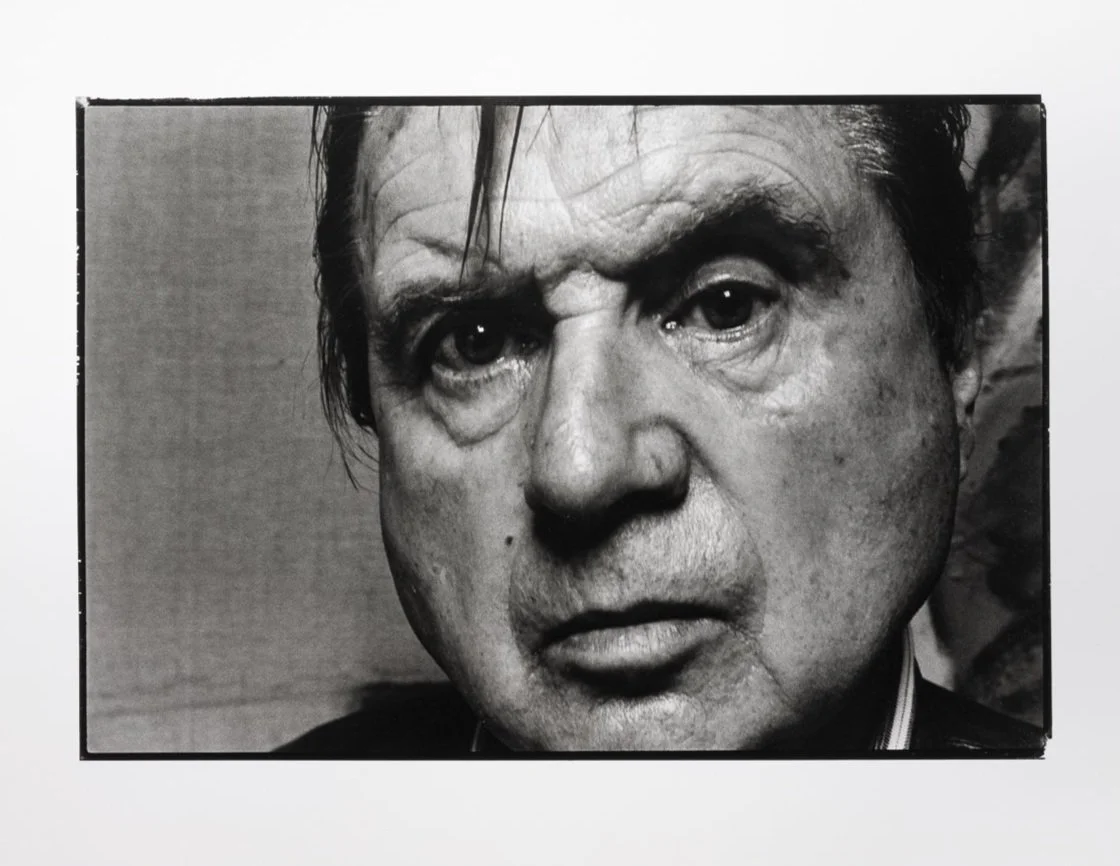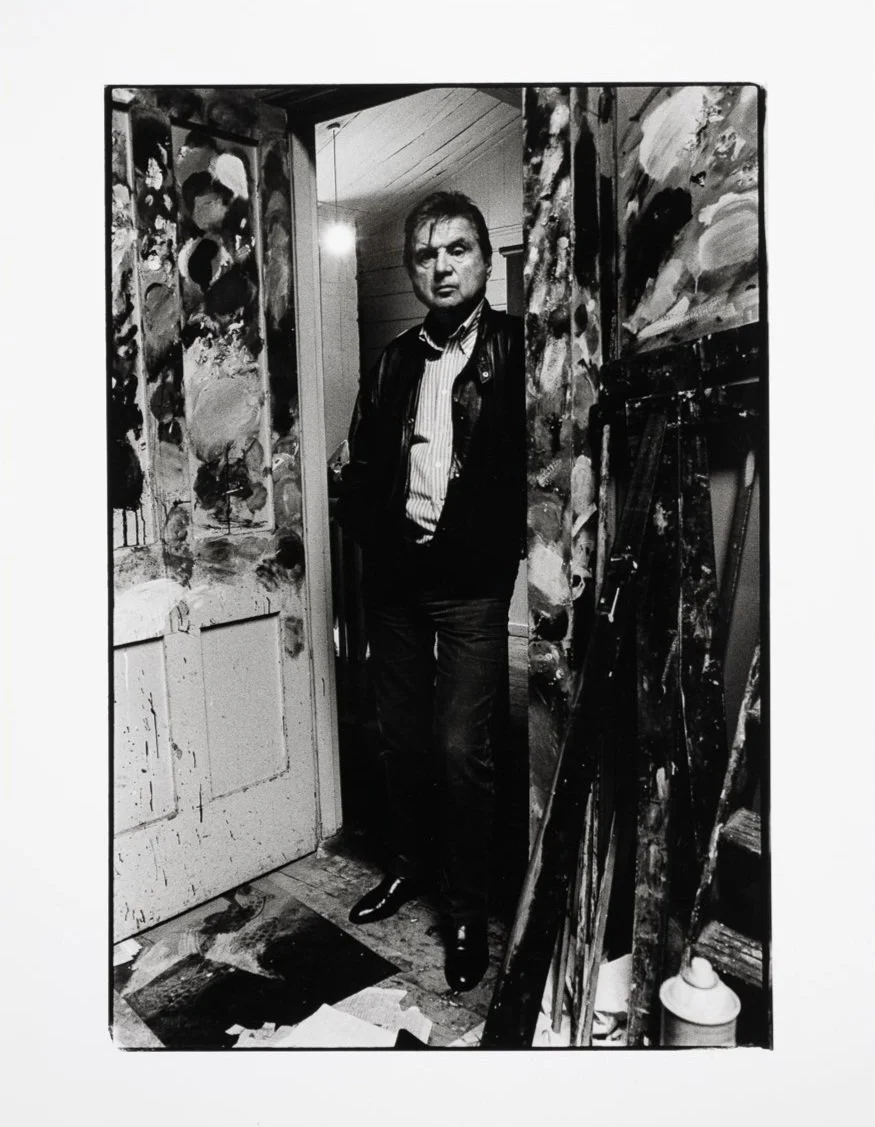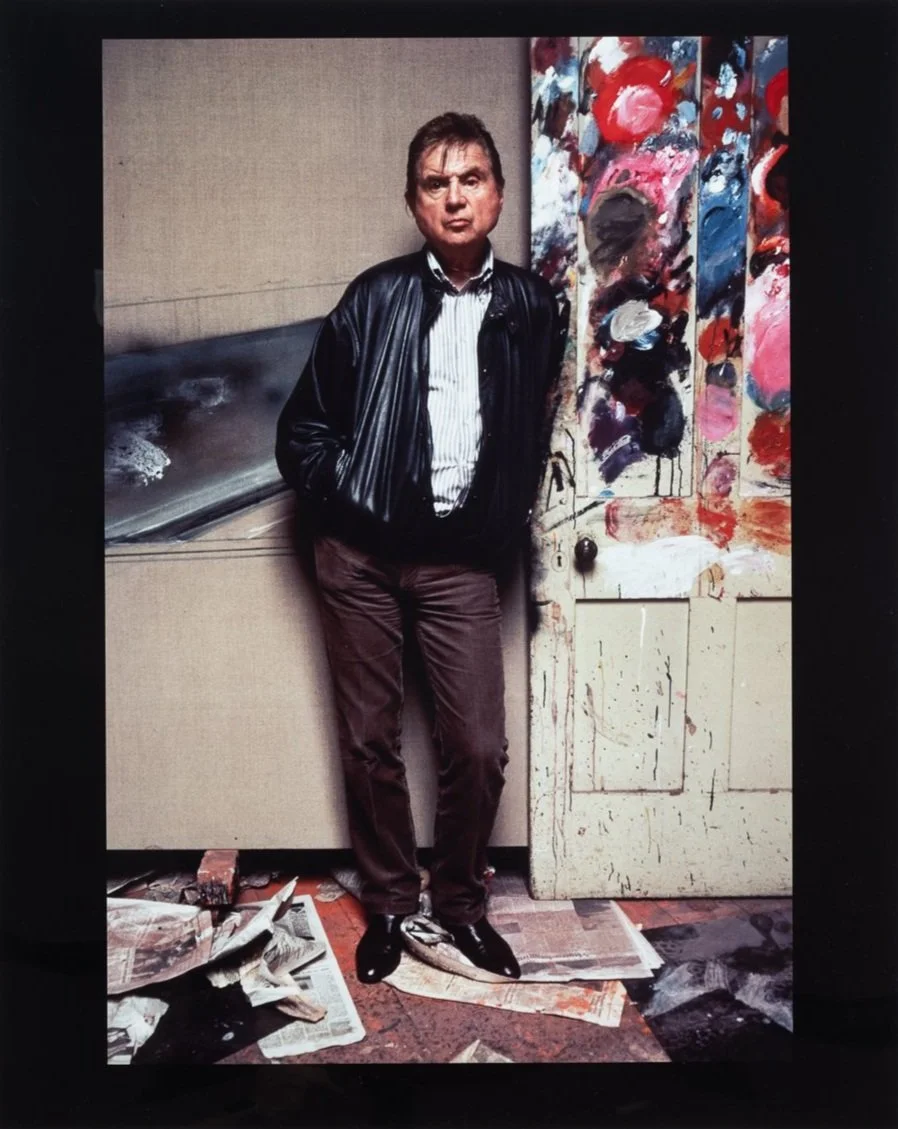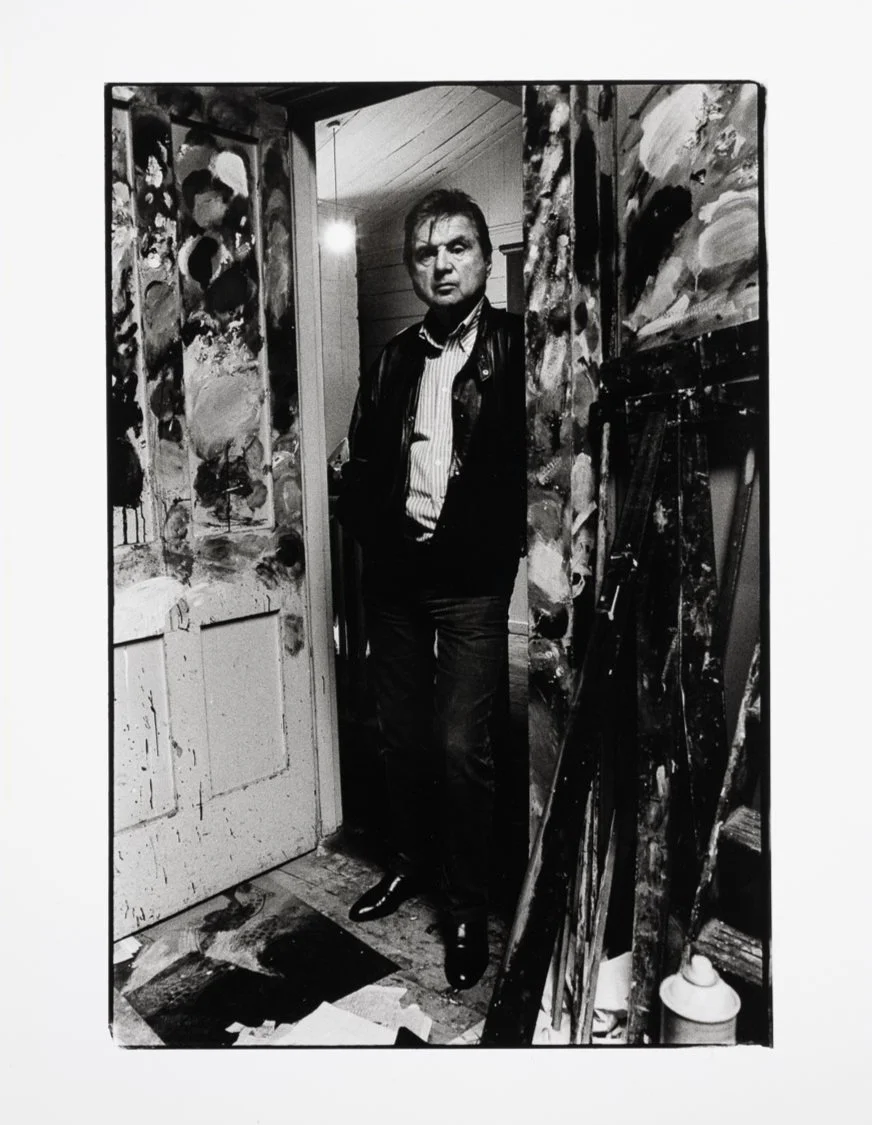
Portraits of Francis Bacon
17 February – 17 April 2022
Online Presentation
Alex Vardaxoglou Gallery is thrilled to present Portraits of Francis Bacon, an Online Presentation bringing together a set of eight important portraits by renowned British photographer Bruce Bernard (1928-2000) of his friend Francis Bacon (1909-1992). The photographs we present are lifetime cibachromes and bromide prints, compiled by the artist himself shortly before his death and gifted as a set to a collector. The Presentation continues the Gallery’s interest in quality works of twentieth century British Art.
Francis Bacon in his Studio, 1984 (1999) © The Estate of Bruce Bernard, courtesy Virginia Verran (The Estate of Bruce Bernard). Enquire below.
Bernard’s photographs were taken around 1984 and document Bacon in his Reece Mews studio in the final decade of his life. Intense close-ups in front of his paint-splattered door are alongside full-body portraits and more unfamiliar settings, for example in Bacon’s kitchen. Across all the photographs, Bacon comes across stern but surprisingly youthful. Bernard is an extremely gifted photographer in capturing Bacon with no pretence at a time of great critical attention and public admiration for the painter.
The pictures are distinct from others of Bacon as he knew they were not intended for a particular purpose and might never be seen. Bernard had just been gifted a camera and decided that he would like to photograph his friend. During shooting, according to Bernard, something curious was happening in Bacon’s mind, as he became preoccupied and seemed depressed when facing the camera; “he seemed just a little dressed up and the shine on his shoes was unnaturally perfect”. Writing in 1998, Bernard thought Bacon was “rather like a girl who had dressed for a dance but felt displeased with whoever it was she was going to it with”.
Francis Bacon in his Kitchen/Bathroom, 1984 (1999) © The Estate of Bruce Bernard, courtesy Virginia Verran (The Estate of Bruce Bernard). Enquire below.
Importantly, the photographs document Bacon’s working environment, and interesting elements stand out, like Bacon’s orderly kitchen alongside his door-as-palette, and messy studio floor. Bernard writes “anyone could be forgiven for thinking Francis indifferent, bored and even hostile towards me, but although he was perfectly friendly before and after each session (cups of tea and small-talk to begin with), he became preoccupied and seemed a little depressed when faced by the camera or even to be harbouring hostile thoughts about someone”.
During the 1980s Bacon exhibited in institutions all over the world and was at the height of his fame. Tate Britain celebrated him with a second retrospective in 1985, with the then director Sir Alan Bowness declaring him the ‘greatest living painter.’ However according to Bernard at this point Bacon’s marvellous humour of the past decades had diminished, and he felt defensive about his work, to the extent of alienating his few good painter friends, like Auerbach and Freud.
Despite this, Bacon was advancing his painting, as his canvases became more minimal and backgrounds were often reduced to monochromatic colour planes. Abstract perspective lines continued to deliver subtle indications of depth and space. As a consequence, the emphasis on the figure was amplified and in no other period was the focus on the depicted subject so direct. Bacon’s protagonists similarly became quieter; and so did Bacon himself, as masterfully documented by Bruce Bernard.
Bruce Bernard’s photographs have been exhibited in a number of galleries and institutions, including Alex Vardaxoglou, London (2021); Gagosian, London (2017); Sainsbury Centre, Norwich (2010); Hayward Gallery, London (2008); Hazlitt Holland-Hibbert, London (2007); Tate, London (2002); V&A, London (2002).
For enquiries please contact info@vardaxoglou.com.
Francis Bacon in his Studio Doorway (Light On), 1984 (1999) © The Estate of Bruce Bernard, courtesy Virginia Verran (The Estate of Bruce Bernard). Enquire below.
Francis Bacon in his Studio Doorway, 1984 (1999) © The Estate of Bruce Bernard, courtesy Virginia Verran (The Estate of Bruce Bernard). Enquire below.
Francis Bacon in his Studio, 1984 (1999) © The Estate of Bruce Bernard, courtesy Virginia Verran (The Estate of Bruce Bernard). Enquire below.
Francis Bacon in his Studio, 1984 (1999) © The Estate of Bruce Bernard, courtesy Virginia Verran (The Estate of Bruce Bernard). Enquire below.
Bruce Bernard writes, "[Bacon] hit Soho like a welcome and highly stimulating whirlwind in 1948. He seemed quite unique to me at twenty – magical – his extraordinary energy and intelligence allowing him a marvellous overflow of frivolity that came from far too interesting a person to be regarded simply as ‘camp’. Lucian later described him as the ‘wisest and wildest’ person he had even known. Francis’s centre in Soho was Muriel Belcher’s Colony Room, a one-room drinking club singular as its proprietor. Francis and Muriel had a special love for each other and for a time she paid him £10 a night with drinks to bring people with money in. He had little difficulty in finding them and he was also pursued by those who knew what a remarkable painter he was. He could, though, be coldly dismissive and really funnily and mercilessly bitchy when he wasn’t seeming actually to radiate sweetness and light. I remember being a little disappointed by his first show at the Hanover Gallery in 1949, but I thought that there was nothing to compare with the masterpiece Painting 1946 shown at the Redfern Gallery. Not long afterwards, at the Colony, I asked him what he was up to. With a rather wistful smile he said ‘… well, I’m trying to do something with Van Gogh but I don’t know whether it will work…’
Only a few days later I was asked to carry a very wet canvas into the Hanover Gallery which was one of the series based on Vincent’s The Painter on his Way to Work. Perhaps only two of them were really fit to enter the canon but the whole idea was so audacious, and one would have thought anyone else unhinged or simply stupid to have attempted it. Naturally I followed Francis’s work to the end and if I liked very little of what came out of his last decade it was because he seemed to have almost entirely displaced his initial inspired exploitation of chance with preconception and virtuosity (a very drawn out process with many powerful syntheses along the way) and his raw-nerved and real figures with voluptuous ones or things he only took a curious pleasure in. I very much regret that I fell out with him about a publication idea, because it robbed me of the encouragement his friendship gave me. I wish he could have died laughing at a really funny and entirely new notion. I will never forget what exhilarating company he could be, or my conviction that his greatness as a twentieth-century artist will be acknowledged as long as anyone cares about the painting of pictures."
— Bruce Bernard in the exhibition catalogue for From London, an exhibition of works by Francis Bacon, Lucian Freud, Leon Kossoff, Michael Andrews, Frank Auerbach and R B Kitaj organised by the British Council in association with the Scottish National Gallery of Modern Art. 1995
— 12 Photographs of Francis Bacon by Bruce Bernard published 1999 by Visual Arts The British Council © The Estate of Bruce Bernard, courtesy Virginia Verran (The Estate of Bruce Bernard)
List of Works
Click image to Enquire
-

Head of Francis Bacon, 1984 (1999)
Bruce Bernard (1928-2000)
bromide print (lifetime print)
40 x 51 cm / 15 3/4 x 20 1/8 in
-

Francis Bacon in his Kitchen/Bathroom, 1984 (1999)
Bruce Bernard (1928-2000)
bromide print (lifetime print)
39 x 50 cm / 15 3/8 x 19 3/4 in
-

Francis Bacon in his Studio Doorway, 1984 (1999)
Bruce Bernard (1928-2000)
bromide print (lifetime print)
50 x 40 cm / 19 3/4 x 15 3/4 in
-

Francis Bacon in his Studio Doorway (Light On), 1984 (1999)
Bruce Bernard (1928-2000)
bromide print (lifetime print)
50 x 40 cm / 19 3/4 x 15 3/4 in
-

Francis Bacon in his Studio, 1984 (1999)
cibachrome print (lifetime print)
51 x 40 cm / 20 1/8 x 15 3/4 in
-

Francis Bacon in his Studio, 1984 (1999)
Bruce Bernard (1928-2000)
cibachrome print (lifetime print)
50.5 x 40.5 cm / 19 7/8 x 16 in
-

Francis Bacon, 1984 (1999)
Bruce Bernard (1928-2000)
cibachrome print (lifetime print)
40.5 x 50.5 cm / 16 x 19 7/8 in
-

Francis Bacon in his Studio, 1984 (1999)
Bruce Bernard (1928-2000)
cibachrome print (lifetime print)
50.5 x 40.5 cm / 19 7/8 x 16 in
All images © The Estate of Bruce Bernard, courtesy Virginia Verran (The Estate of Bruce Bernard)
Permission must be sought to publish images online, please email info@vardaxoglou.com to request authorisation

